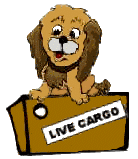|
|
|
-
Make sure your dog is healthy!!!!
-
Purchase an airline approved crate well in
advance and thoroughly familiarize him with it.
-
If it's summer, choose an
early morning flight, or late evening flight if possible.
-
Don't fly your dog if the
temperature is over 30 degrees Celsius (85F)
-
Ensure that you comply
with any/all special restrictions for entry into the state of
destination.
-
Make sure that your crate
is of adequate size for your dog. Large enough for him to stand up in,
but not so large that he gets thrown from side to side. The less they can
see, the happier they will be!
-
Place a familiar scented
soft rug in the crate.
-
Don't feed your dog a full
meal within twelve hours of flying. They do not travel well on a full
stomach.
-
Don't fly a puppy under 12
weeks of age.
-
Tranquillizing
animals who are flying is
not a good idea as the medication can cause respiratory and
cardiovascular problems when the animal is at high altitudes.
** At a meeting between USDA and airline officials, the AVMA learned that
over-sedation is the most frequent cause of animal deaths during airline transport. Though very few of the thousands of animals transported during the past five years have died while being transported, investigations revealed that almost half the deaths results from sedation. The second most frequent cause of death was environmental stress, especially in brachycephalic (pug and snub nose) breeds. Third in frequency were disease complications from coronavirus, parvovirus and respiratory diseases that were not evident during examination, but had a sudden, debilitating onset with the stress of transport at high altitude. Least common, in fact, rare, were deaths caused by mishandling by the carriers.
JAVMA, Vol. 207, No. 6, Sept. 1995 **
-
On the crate, securely
tape details of your dog, airline, flight numbers, destination, your name
and contact phone number, the name and contact numbers of the person to
whom the dog is going. (I also include my dogs name on the label, in the
event that they should ever escape from their crate, I believe there is
more chance of catching them in a scary situation if calling them by
name).
-
Stick a few strips
of bright fluorescent tape on the outside of the crate so it is
readily
visible.
-
Double check all the screw
fittings to make sure they are tight.
-
Ensure that the crate door
is securely closed. I use plastic ties to secure mine, or wrap a strip of
tape right around the cage in front of the door.
-
Tie a lead on the handle
of the crate, for use in the event of an emergency.
-
Exercise your dog
immediately so that he may relieve himself before you place him in the
crate and check him in to the airline. Be sure to take some "poop
scoop" bags with you!
-
Wait and watch your dog
being loaded on the flight.
-
If the plane is delayed at
the gate or on the runway for any length of time, insist they take your dog off!
-
If the only flight
connections are through a major airport where they will have to change
planes, try to get another flight that goes through a smaller airport
where they will continue on to their destination on the same plane! I
strongly recommend using non-stop flights!
-
If it's going to be a
lengthy flight, freeze a small amount of
water in the bottom of the water bowl and place in the crate at the last
minute.
-
Ensure that the person
collecting the dog at the other end calls you to confirm the arrival and
condition of the dog.
-
If the flight is delayed,
phone the person who is collecting the dog at the destination, and advise
them of the delay.
-
If something should
happen, contact the airlines, give them the consignment number, and
insist that they follow up immediately and give you full details of the
whereabouts of your dog! Speak with management.
|
|

|
|
|
CAR SICKNESS: 10 HINTS TO HELP YOUR PET STOMACH IT
Travel on empty. It's a good idea not to feed your pet six to eight hours before embarking on a road trip, advises Clayton MacKay, D.V.M., director of the veterinary teaching hospital at Ontario Veterinary College at the University of Guelph in Canada and president of the American Animal Hospital Association. Having an empty stomach will make him less likely to throw up. "And if he does get sick, there's no food in the vomit, so at least it's easier to clean up," he says. Giving your pet water, however, won't upset his stomach and may make him more comfortable.
Or put in a quarter-tank. While some pets travel best on an empty stomach, others will feel more comfortable after eating a small meal. "They just need a little food in their stomach to help keep them from getting sick," says Dr. MacKay.
Take frequent rest breaks. While some pets can travel for hours without having problems, others start getting queasy after a few miles. "Get to know your pet's pattern," says Dr. MacKay. He recommends stopping at least every hour or two and taking a quick walk to help your pet get his land-legs back. It's also a good idea to pour him a little water, since he may not feel like drinking when he's in the car.
Cruise carefully. "Be considerate of your carsick pet, just as you would if you had a carsick child," says Gary Beard, D.V.M., assistant dean at the Auburn University College of Veterinary Medicine in Alabama. "Don't fly around curves, and take it slower than you normally would."
Be up-front with him. "There's not as much movement in the front of the car as in the back, so it might help your pet if you let him ride in the front seat," says William G. Brewer, D.V.M., assistant professor of small animal internal medicine in the Department of Small Animal Surgery and Medicine at the Auburn University College of Veterinary Medicine. To keep your friend safe, you may want to invest in a doggy seatbelt. Or you can buy a small kennel that buckles into the seat.
Expand his horizons. Pets, like people, are less likely to get carsick when they can watch the passing scenery. "Allow your pet to look out the window, and he'll probably fare much better than if he has nothing to set his sights on," says Bernhard P. Pukay, D.V.M., a veterinarian in private practice in Ottawa, Canada, and host of the Discovery Channel's Pet Connection.
Crank down the windows. "Fresh air is good for anyone who's feeling a little carsick, including your dog or cat," says Dr. Pukay. "But don't open the window enough so he can escape or get his head way out," he adds.
Try a motion potion. Dimenhydrinate (Dramamine) -- the same drug people take to ward off car sickness -- also works for pets, says James B. Dalley, D.V.M., associate professor of small animal clinical sciences at the Michigan State University College of Veterinary Medicine in East Lansing. Medium to large dogs should be given 25 to 50 milligrams of Dramamine at least an hour before traveling, says Dr. Dalley. Cats and small dogs should get about 12.5 milligrams.
Dramamine is available in 50-milligram tablets that can be split into quarters to provide the right dose for your pet. Vets say it's safe for most healthy dogs and cats, although pets with glaucoma or bladder problems shouldn't take it without a veterinarian's approval.
Don't drive him to despair. For many pets, it's not motion that causes car sickness but fear. "Don't make going to the vet the only time your pet rides in the car, or you're asking for an anxious and possibly sick pet," says David Hammond, D.V.M., a veterinarian in private practice in Pleasant Hill, Oregon, and veterinary affairs manager for Hill's Pet Nutrition. Allowing him to accompany you occasionally on more pleasant jaunts will help keep his tummy calm at all times.
Allay his anxiety. Some pets become almost panicky about being in a moving vehicle, says Dr. MacKay. To help him overcome his fear -- as well as the resulting nausea -- try making the car a pleasant place to be. "Take your pet to the car and just sit there without the engine on," suggests Dr. MacKay. "Give him a treat if you like. Do this for seven to ten days. Then one day, start the car. Praise him, talk to him, possibly give him a treat. Do this for several minutes a day for the next few days."
Once your pet is used to just sitting in the car, try taking short trips, suggests Dr. MacKay. Begin by driving around the block, then gradually work up to longer distances. His car sickness should eventually start to improve. "It takes time," says Dr. MacKay, "but it's worth the work."
From Petsmart
Tip: If you have a puppy constantly suffering
from car sickness, ask your Vet about giving him Metomide tablets. |

|
LINKS TO CANINE
TRAVEL SITES
|
-
DOG-FRIENDLY ACCOMMODATION IN PERTH, WA
Our own on-line list
-
DOGS
ON TOUR (UK)
This is a great site! Everything you want to know about showing or travelling in the UK!
-
PUBS
THAT LOVE DOGS - U.K.
Regularly
updated list of pubs in the UK, partial to dogs!
-
TRAVEL
PETS
Free on-line
directory to Pet Friendly Hotels in the United States
and Canada (some
International)
-
PETS
WELCOME
Over 25,000
listings of where to stay with your pet! A great site.
-
PAWS
FOR TRAVEL
Information about the new
quarantine deregulation in the UK, pet friendly hotels in the UK and
Europe and travel tips from the team and vets.
-
PET
FRIENDLY
Full page featured photo
listings and searchable database of the best pet friendly places in the
U.K. Ireland and France!
-
AUSTRALIAN
QUARANTINE
A guide to
importing dogs into Australia.
-
TRAVELLING
DOGS
Pet travel
and dog fun
-
UNITED
AIRLINES
Rules &
guidelines when flying with your pet.
-
PAWS
4 TRAVEL CO. U.K.
Using the Pet Passport system.
-
DOGGY HOLIDAY
AUSTRALIA
A guide to many of the
Australian and New Zealand holiday destinations which are dog friendly.
-
TRAVELIN'
PETS
If you are looking for a pet travel product, they have it!
-
AUSEMADE
TRAVEL
Links to Australian
pet-friendly accommodation
-
CARAVANNING
& RV'ING IN AUSTRALIA
Pet-friendly
caravan parks
-
PETS ON THE
GO
Database of 18,000 B&Bs, inns, motels, hotels and resorts that welcome
pets in the USA.
-
PET
TRAVEL
17,989 pet friendly accommodations and services in 107 countries worldwide!
-
TRAVEL PROBLEMS
Safe airline travel with your dog.
|
|
| Visit our
IMPORT/EXPORT
& QUARANTINE INFORMATION (Worldwide) Page |
|
|
Animal Freight Companies
Click
on their name for their web page.
|
|
|
|


|
|